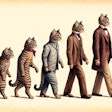
Pet ownership in the United States has remained steady on average during the past 14 years. In 2010, 62% of U.S. households included a pet of any kind. In 2024, that figured had risen to 63%. However, that modest increase followed fluctuations in ownership rates. Ingrid Chu, vice president of research and insights for the American Pet Products Association (APPA) shared that information and more of her organization’s research on pet ownership during her Global Pet Expo 2024 presentation on March 21 in Orlando, Florida, USA.
“Generally, things are stable,” she said. “We did see that we got a nice bump, especially among dogs, during COVID… We are seeing that things are starting to normalize going back to where they were before COVID. We are forecasting more stabilization. It'll probably go back up to around two thirds, and then stay like that for the next several years, which is a good thing. That's an opportunity for us.”
COVID wasn’t the only time pet ownership rates increased above the long-term trend. Particularly in 2012, 2016 and with the pandemic disruptions of 2020, pet ownership increased beyond the current rate of 63%. The overall trend of ownership has ranged into the high 60’s range, but not below that baseline of 62% in 2010. By 2020, APPA analysts predict that the overall pet ownership rate in the US will climb to 67%.
Dog ownership has consistently outpaced cat ownership. In 2010, 39% of U.S. households owned a dog. Dog ownership peaked in 2020 during the pandemic, settling down to 44% in 2024. APPA analysts forecast that dog ownership would rise slowly to 46% by 2030.
Although cat ownership will lag dog into the future, the number of households with pet cats may increase more rapidly. In 2010, 33% of U.S. households kept cats. That figure actually declined to 30% in 2024, while not seeing the pandemic bulge that dog ownership did. By 2030 though, APPA market researchers believe cat ownership will climb to 35%.
Future pet ownership trends
Changes in human living patterns, including urbanization, along with mandates that workers return to their brick-and-mortar offices, may boost the growth of cat ownership.
“We've seen a growth in cat,” David McLain, CEO and president of Alphia, told Petfood Industry. “We do a lot of great stuff in cat because of our focus on palatability. I think that you've seen a little bit of ownership fall off for dogs. You've seen less with cats. There's more sustainability there. I think it's because some people are going back to work. Cats are easier to support with that lifestyle.”
The percentage of households owning pets has held relatively steady since 2010, while the overall number of pet-owning households has grown along with the rising population of the U.S. In 2010, 73 million households included pets, rising to 82 million by 2024. Dog-owning households grew the most, rising from 46 million to 58 million. Households with pet cats increased from 39 million to 40 million.
However, APPA analysts don’t forecast a significant increase in pet-owning households. By 2030, the number may rise by only one million, with dog ownership declining to 57 million households and cat rising to 45 million.


















